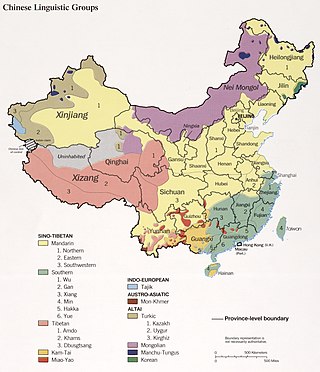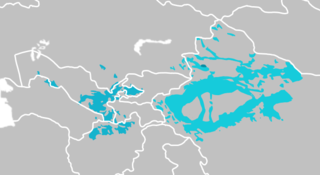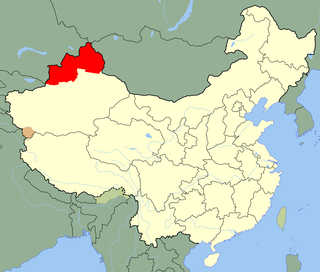Related Research Articles

The Uyghurs, alternatively spelled Uighurs, alternatively spelled Uighurs, Uygurs or Uigurs, are a Turkic ethnic group originating from and culturally affiliated with the general region of Central and East Asia. The Uyghurs are recognized as native to the Xinjiang Uyghur Autonomous Region in Northwest China. They are one of China's 55 officially recognized ethnic minorities. The Uyghurs are recognized by the Chinese government as a regional minority and the titular people of Xinjiang.

Kazakh or Qazaq is a Turkic language of the Kipchak branch spoken in Central Asia by Kazakhs. It is closely related to Nogai, Kyrgyz and Karakalpak. It is the official language of Kazakhstan and a significant minority language in the Ili Kazakh Autonomous Prefecture in Xinjiang, north-western China and in the Bayan-Ölgii Province of western Mongolia. The language is also spoken by many ethnic Kazakhs throughout the former Soviet Union, Germany, and Turkey.

Uzbek, formerly known as Turki, is a Turkic language spoken by Uzbeks. It is the official, and national language of Uzbekistan. Uzbek is spoken as either native or second language by 44 million people around the world (L1+L2), making it the second-most widely spoken Turkic language after Turkish. There are two major variants of Uzbek language, Northern Uzbek spoken in Uzbekistan, Kyrgyzstan, Kazakhstan, Tajikistan, Turkmenistan and China and Southern Uzbek spoken in Afghanistan and Pakistan.

Kyrgyz is a Turkic language of the Kipchak branch spoken in Central Asia. Kyrgyz is the official language of Kyrgyzstan and a significant minority language in the Kizilsu Kyrgyz Autonomous Prefecture in Xinjiang, China and in the Gorno-Badakhshan Autonomous Region of Tajikistan. There is a very high level of mutual intelligibility between Kyrgyz, Kazakh, and Altay. A dialect of Kyrgyz known as Pamiri Kyrgyz is spoken in Afghanistan and Pakistan.

Chagatai, also known as Turki, Eastern Turkic, or Chagatai Turkic, is an extinct Turkic literary language that was once widely spoken across Central Asia and remained the shared literary language there until the early 20th century. It was used across a wide geographic area including parts of modern-day Uzbekistan, Xinjiang, Kazakhstan, and Kyrgyzstan. Literary Chagatai is the predecessor of the modern Karluk branch of Turkic languages, which include Uzbek and Uyghur. Turkmen, which is not within the Karluk branch but in the Oghuz branch of Turkic languages, was nonetheless heavily influenced by Chagatai for centuries.

There are several hundred languages in China. The predominant language is Standard Chinese, which is based on Beijingese, but there are hundreds of related Chinese languages, collectively known as Hanyu, that are spoken by 92% of the population. The Chinese languages are typically divided into seven major language groups, and their study is a distinct academic discipline. They differ as much from each other morphologically and phonetically as do English, German and Danish, but meanwhile share the same writing system (Hanzi) and are mutually intelligible in written form. There are in addition approximately 300 minority languages spoken by the remaining 8% of the population of China. The ones with greatest state support are Mongolian, Tibetan, Uyghur and Zhuang.

The Uyghur or Uighur language is a Turkic language written in a Uyghur Perso-Arabic script with 8–13 million speakers, spoken primarily by the Uyghur people in the Xinjiang Uyghur Autonomous Region of Western China. Significant communities of Uyghur speakers are also located in Kazakhstan, Pakistan, Kyrgyzstan, and Uzbekistan, and various other countries have Uyghur-speaking expatriate communities. Uyghur is an official language of the Xinjiang Uyghur Autonomous Region; is widely used in both social and official spheres, as well as in print, television, and radio; and is used as a common language by other ethnic minorities in Xinjiang.
Uyghur is a Turkic language with a long literary tradition spoken in Xinjiang, China by the Uyghurs. Today, the Uyghur Arabic alphabet is the official writing system used for Uyghur in Xinjiang, whereas other alphabets like the Uyghur Latin and Uyghur Cyrillic alphabets are still in use outside China, especially in Central Asia.

Salar is a Turkic language spoken by the Salar people, who mainly live in the provinces of Qinghai and Gansu in China; some also live in Ili, Xinjiang. It is a primary branch and an eastern outlier of the Oghuz branch of Turkic, the other Oghuz languages being spoken mostly in Western and Central Asia. The Salar number about 105,000 people, about 70,000 (2002) speak the Salar language; under 20,000 are monolinguals.

Xinjiang historically consisted of two main geographically, historically, and ethnically distinct regions with different historical names: Dzungaria north of the Tianshan Mountains; and the Tarim Basin south of the Tianshan Mountains, currently mainly inhabited by the Uyghurs. They were renamed Xinjiang in 1884, meaning "new frontier," when both regions were conquered by the Manchu Qing dynasty after the Dungan revolt (1862–1877).
Ili Turki is an endangered Turkic language spoken primarily in China. In 2007, it was reported that there were around 30 families using it in China.
Lop, also known as Lopnor or Lopnur is a Turkic dialect spoken in the Lopnor region of Xinjiang, China. Lop speakers are officially classified as ethnic Uyghurs by the Chinese government.

The Karluk or Qarluq languages are a sub-branch of the Turkic language family that developed from the varieties once spoken by Karluks.
The Uyghur Cyrillic alphabet is a Cyrillic-derived alphabet used for writing the Uyghur language, primarily by Uyghurs living in Kazakhstan and former CIS countries.
Uyghur is a Turkic language spoken mostly in the west of China.

The Ili Rebellion was a Uyghur separatist movement backed by the Soviet Union against the Kuomintang government of the Republic of China in 1944. After the start of the rebellion, the rebels established the Provisional Government of the Second East Turkestan Republic in 1944. The Ili Rebellion was the start of the East Turkistan National Liberation Revolution, also known as the Three Districts Revolution, which lasted from 1944 to 1949.
This article covers the phonology of the Uyghur language. Uyghur, a Turkic language spoken primarily in the Xinjiang Uyghur Autonomous Region features both vowel harmony and vowel reduction.
Ibrahim Muti'i was a well-known linguist from Xinjiang, China. He is best known for his research on Uyghur language and culture. He is considered to have been one of the top scholars of his generation in Uyghur.
Edkhyam Rakhimovich Tenishev was a Soviet and Russian linguist who specialized in Turkic and Mongolic languages. He was a doctor of philology, a professor, and a corresponding member of the Academy of Sciences of the Soviet Union. He served as the head of the Department of Uralic and Altaic languages at the Institute of Linguistics of the Russian Academy of Sciences. He was editor-in-chief of the journal Советская тюркология(Soviet Turcology) ISSN 0131-677X and of the multi-volume publication Сравнительно-историческая грамматика тюркских языков .
References
Notes
- 1 2 Hahn 1991 , p. 6
- 1 2 3 Yakup 2005 , p. 6
- 1 2 3 Hahn 1998 , pp. 395–396
- ↑ Yakup 2005 , pp. 6–7
- ↑ Yakup 2005 , p. 8
General
- Abdurehim, Esmael (2014), The Lopnor dialect of Uyghur - A descriptive analysis (PDF),Publications of the Institute for Asian and African Studies 17,Helsinki: Unigrafia, ISBN 978-951-51-0384-0
- Hahn, Reinhard F. (1991), Spoken Uyghur, London and Seattle: University of Washington Press, ISBN 978-0-295-98651-7
- Hahn, Reinhard F. (1998), "Uyghur", in Johanson, Lars; Csató, Éva Ágnes (eds.), The Turkic Languages, Routledge, pp. 379–396, ISBN 978-0-415-08200-6
- Yakup, Abdurishid (2005), The Turfan Dialect of Uyghur, Turcologica, vol. 63, Wiesbaden: Harrassowitz Verlag, ISBN 3-447-05233-3